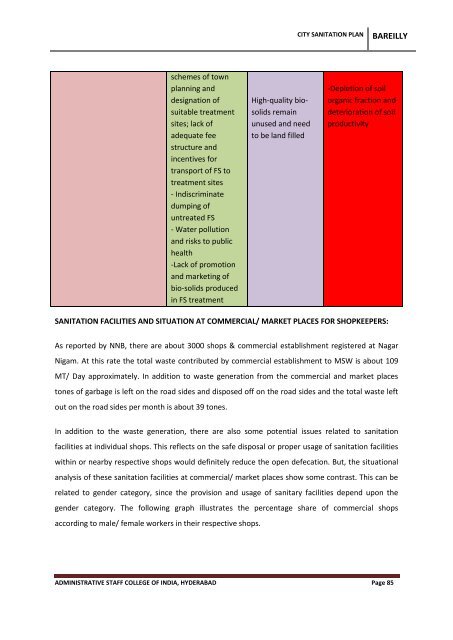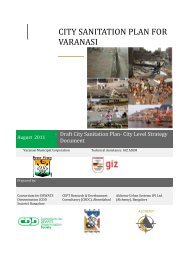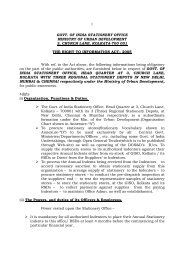CITY SANITATION PLAN - Ministry of Urban Development
CITY SANITATION PLAN - Ministry of Urban Development
CITY SANITATION PLAN - Ministry of Urban Development
Create successful ePaper yourself
Turn your PDF publications into a flip-book with our unique Google optimized e-Paper software.
schemes <strong>of</strong> town<br />
planning and<br />
designation <strong>of</strong><br />
suitable treatment<br />
sites; lack <strong>of</strong><br />
adequate fee<br />
structure and<br />
incentives for<br />
transport <strong>of</strong> FS to<br />
treatment sites<br />
- Indiscriminate<br />
dumping <strong>of</strong><br />
untreated FS<br />
- Water pollution<br />
and risks to public<br />
health<br />
-Lack <strong>of</strong> promotion<br />
and marketing <strong>of</strong><br />
bio-solids produced<br />
in FS treatment<br />
High-quality biosolids<br />
remain<br />
unused and need<br />
to be land filled<br />
<strong>CITY</strong> <strong>SANITATION</strong> <strong>PLAN</strong> BAREILLY<br />
-Depletion <strong>of</strong> soil<br />
organic fraction and<br />
deterioration <strong>of</strong> soil<br />
productivity<br />
<strong>SANITATION</strong> FACILITIES AND SITUATION AT COMMERCIAL/ MARKET PLACES FOR SHOPKEEPERS:<br />
As reported by NNB, there are about 3000 shops & commercial establishment registered at Nagar<br />
Nigam. At this rate the total waste contributed by commercial establishment to MSW is about 109<br />
MT/ Day approximately. In addition to waste generation from the commercial and market places<br />
tones <strong>of</strong> garbage is left on the road sides and disposed <strong>of</strong>f on the road sides and the total waste left<br />
out on the road sides per month is about 39 tones.<br />
In addition to the waste generation, there are also some potential issues related to sanitation<br />
facilities at individual shops. This reflects on the safe disposal or proper usage <strong>of</strong> sanitation facilities<br />
within or nearby respective shops would definitely reduce the open defecation. But, the situational<br />
analysis <strong>of</strong> these sanitation facilities at commercial/ market places show some contrast. This can be<br />
related to gender category, since the provision and usage <strong>of</strong> sanitary facilities depend upon the<br />
gender category. The following graph illustrates the percentage share <strong>of</strong> commercial shops<br />
according to male/ female workers in their respective shops.<br />
ADMINISTRATIVE STAFF COLLEGE OF INDIA, HYDERABAD Page 85
















